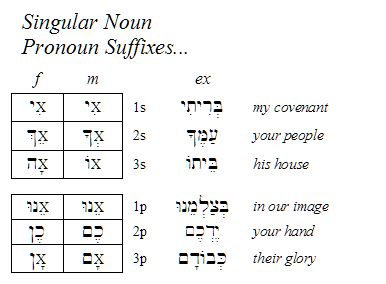|
Hebrew Pronomial Suffixes (Singular Nouns)
Introduction
In this unit we will study one of the most common things that can happen to nouns. In nearly every verse of Scripture you will see suffixes attached to the ends of nouns. These suffixes are called "pronomial suffixes" and function as shortened forms of the possessive personal pronouns.
English Possessive Personal Pronouns
In English we can indicate possession by placing a possessive pronoun (my, your, his, her, etc.) before a noun. For example, in the phrase, "my house," the pronoun "my" functions as a possessive pronoun, indicating that the house belongs to me:
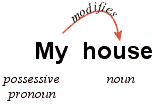
Hebrew Pronomial Endings
In Hebrew, possession can be expressed by attaching "pronomial" endings to nouns. For example, the word for house in Hebrew is "bayit." To say "my house," you would add the 1st person singular ending (which is "-i") to the construct form of the noun (beit) to derive beiti (literally, "the house of me"):

Now before I give you the endings you will see on singular nouns (yes, there is a slightly different set of endings for plural nouns), you need to be aware of two very important things:
- Endings are attached to the construct form of the noun.
That is, the endings do not attach to the lexical form of the noun (i.e., the form you see in the dictionary). For masculine singular nouns, this means you will see some vowel changes; for feminine singular nouns, you will need to remember that if the word ends in a Hey, it changes to Tav (for a review of construct nouns, click here).
- Nouns with pronomial suffixes are considered definite nouns.
When you see a suffix on a noun, consider the noun to be definite. Among other things this means that any adjective that follows the noun must take the definite article (since adjectives, when they are used to directly describe nouns, must agree in definiteness with the noun). This will be clearer as we provide some examples later in this lesson.
Pronomial Endings (for singular nouns)
Recall that Hebrew nouns can be singular or plural. For singular nouns, the following endings can be attached to show possession:
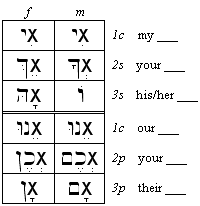
In the paradigm given above, note that the "X" refers to the last letter of the construct form of the noun. Also note that the final Hey in the 3sf form takes a mappiq (in 99% of the cases where you see this, translate as "her ___").
You will need to memorize these suffixes so that when you see a noun with one of these endings, you will understand that a possessive personal pronoun is "embedded" into the meaning of the noun.
Example Paradigm: Bayit (masculine singular)
Recall that the Hebrew word for house is bayit, a masculine noun. In the singular, note that bayit changes its spelling in the construct form:

The pronomial suffixes are attached to the construct form of the noun, not the lexical (or "absolute") form. Thus, attaching the pronomial endings listed above, we have the following paradigm:
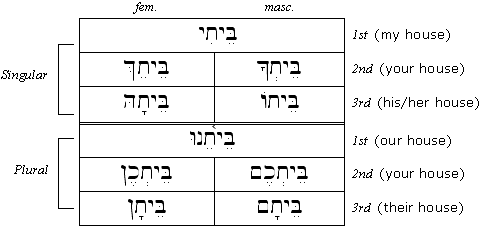
To avoid a potential point of confusion, note that the plural forms do not refer to the noun (which is singular) but to the pronomial endings. For example, beitam means their house, not their houses.
Example Paradigm: Torah (feminine singular)
Recall that the Hebrew word for law or (better) instruction is Torah, a feminine noun. In the singular, note that Torah changes its spelling in the construct form to Torat, and the pronomial suffixes are attached to this form. Thus, attaching the pronomial endings listed above, we have the following paradigm:
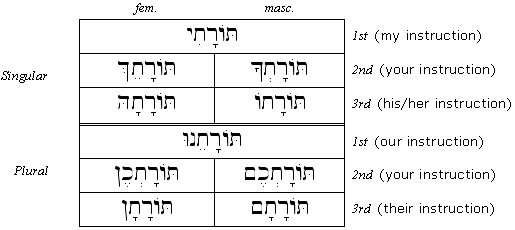
Again, remember that the plural forms listed in the paradigm refer to the pronomial endings. For example, Toratenu means our law (not laws).
Irregular Nouns and Pronomial Suffixes
You should be aware that many of the more common Hebrew nouns change their vowels when the pronomial suffixes are added. For example, the Hebrew noun for son is "ben," but the pronomial endings are added to a variant of the construct form:

The pronomial suffixes are attached to the a modified version of the construct form of the noun. Thus, attaching the pronomial endings listed above, we have the following paradigm:
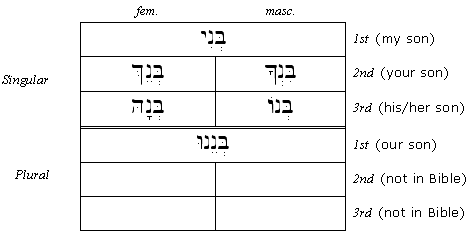
Note that the 2nd and 3rd plural forms do not occur in the Tanakh.
For another example, consider the Hebrew noun for father:

In this case, the construct form is really a disguised version of the 1st person singular possessive (my father). However, when the pronomial endings are added, the Chateph Patach changes to Qamets in the construct form:
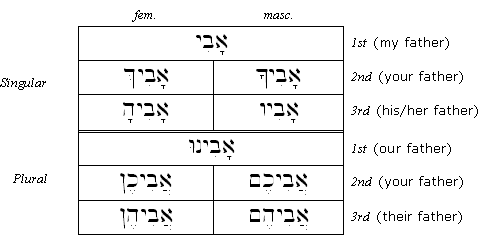
Unfortunately, these sorts of nouns are irregular, and you will need to become familiar with the unusual declension. However, note that the endings remain fairly consistent throughout the paradigms.
Nouns with pronomial suffixes are considered definite nouns
As mentioned above, nouns with pronomial suffixes are considered definite nouns, and any adjective that follows the noun must therefore take the definite article. For example, compare the following:

In the first two lines, note that both the adjective and the noun agree in gender, number, and definiteness (in the second line, the pronomial suffix on the noun makes it definite). In the third line, the adjective does not agree with the noun in definiteness, and is therefore used predicatively.
Section Exercises
- Memorize the pronomial endings for singular nouns.
- Memorize the masculine singular paradigm for Bayit.
- Memorize the feminine singular paradigm for Torah.
- Add the singular pronomial endings to the following words:

(Note that the words following the slash are the construct forms (kol and sus use the same spelling for both absolute and construct forms).
- Add the pronomial endings to other singular nouns you have studied. Use your Hebrew lexicon to confirm your work.
Section Worksheet:
<< Return
|
|












